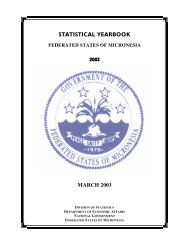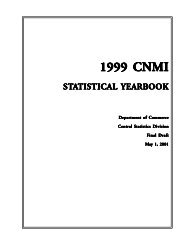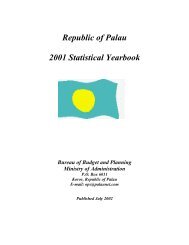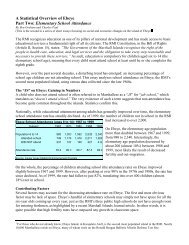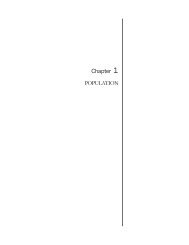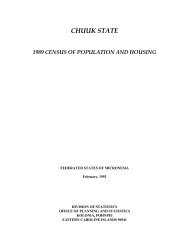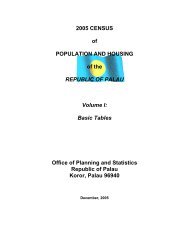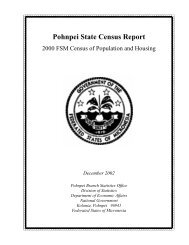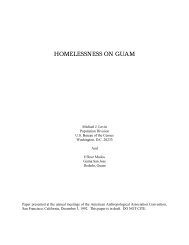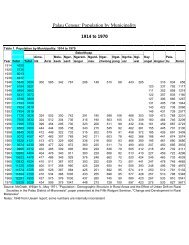Chuuk State Census Report - pacificweb.org
Chuuk State Census Report - pacificweb.org
Chuuk State Census Report - pacificweb.org
You also want an ePaper? Increase the reach of your titles
YUMPU automatically turns print PDFs into web optimized ePapers that Google loves.
2000 FSM <strong>Census</strong> of <strong>Chuuk</strong> <strong>State</strong>Chapter 1. Introductionmen had been repatriated to Japan. The only other foreigners in <strong>Chuuk</strong> were 7 Germans and 7 Spaniards, the Germansbeing Protestant and the Spaniards being Catholic missionaries. At the end of the war there were some 1,500 Japaneseand Okinawans civilians in <strong>Chuuk</strong>, all of whom were shipped back to their home countries.American AdministrationOnce again the spoils of war, Micronesia passed into the hands of the United <strong>State</strong>s. Early American developmentpolicy for the islands was defined more in reaction to earlier Japanese policy than in any more positive way. AllJapanese nationals, including those who had been married to <strong>Chuuk</strong>ese women, were repatriated as soon as possible.Hence, the pool of skilled labor that created the economic miracle in the 1930s was lost forever. The United <strong>State</strong>sNavy, which was then administering the islands, further pledged to avoid all "indiscriminate exploitation" of islandresources. There would be economic development projects funded by outside capital. Any economic development thatoccurred was to benefit the local people and be subject to their control. This was to set the pattern for the islandsduring their first two decades under American rule.United Nations trusteeship in 1947 and civilian administration under the Department of the Interior in 1951 hadvirtually no impact on the United <strong>State</strong>s' "go slow" development policy. The Island Trading Company replaced theUnited <strong>State</strong>s Commercial Company, which had been introduced by the Navy in 1946 to supervise economicdevelopment, a year later. This, in turn, spawned local import-export businesses such as the Truk Trading Company.Retail stores multiplied and the production of copra and handicraft was encouraged. Experimental projects in suchthings as cacao, ramie, choir fiber, and poultry were begun, but nearly all proved failures.Although unwilling to impose development programs on the people, the United <strong>State</strong>s showed no such hesitation inpromoting democratic political practices. From the very start the United <strong>State</strong>s attempted to set up democratic forms ofgovernment on every level of island society. In 1948 municipalities were established and elections were held formagistrates. At first the people of most places chose the head of the highest ranking clan on the island; but in time, as itbecame clear that the magistrates would be expected to deal with American government officials, some of the chiefspicked surrogates whom they supported in the elections. Later the magistrates of some islands would carve out aleadership role for themselves that was more independent of the chiefs.Meanwhile, training programs were established for teachers and nurses, with the Pacific Islands Teacher TrainingSchool (PITTS) moving from Guam to <strong>Chuuk</strong> in 1952. Later the institution evolved into the first full high school(PICS) in the Trust Territory. During the 1950s this school graduated 10 or 15 <strong>Chuuk</strong>ese a year, a mere five percent ofthe output of high school graduates during the 1970s. Only a few hundred people had any salary employment duringthese years, most of them in lower level positions in the government.Then, in the early 1960s, during the Kennedy Administration, United <strong>State</strong>s policy was suddenly reversed. A massivebuildup of education and health services was undertaken as the Trust Territory budget doubled in 1964 and escalatedeach year to the end of the decade. New classroom buildings were put up everywhere and American teachers wererecruited to upgrade educational standards. <strong>Chuuk</strong> acquired its own high school, and several years later five junior highschools. Education enrollments, particularly on the secondary level, increased many times over, and in the early 1970s,with the help of United <strong>State</strong>s Federal assistance, unprecedented numbers of <strong>Chuuk</strong>ese began going abroad for college.All the while, new government jobs were created as employment in <strong>Chuuk</strong> doubled and then doubled once again. Thegovernment was now more than ever the engine that drove the economy. Exports remained at the level of the 1950s,bringing in a few hundred thousand dollars a year while imports skyrocketed throughout the following years.Belatedly during the 1970s the United <strong>State</strong>s administration made attempts to halt the galloping wage-and-consumptiondirection of the economy. A ceiling was put on the annual budget, but supplementary funds in the form of United<strong>State</strong>s Federal Program grants and Capital Improvement Project funds fostered the same cycle until 1979. The yearbefore, <strong>Chuuk</strong> elected its first governor and the state became self-governing after nearly a century of colonial rule. Itspolitical status was formalized in 1986 when the Federated <strong>State</strong>s of Micronesia's Compact of Free Association withthe United <strong>State</strong>s was implemented. With <strong>Chuuk</strong>’s political status finally settled -- at least for the next 15 years -- thestate was free to devote full attention to its main problem: developing a viable economy.<strong>Chuuk</strong> Branch Statistics Office, Division of Statistics, FSM Department of Economic Affairs 11



